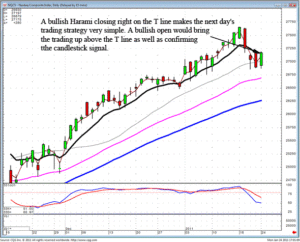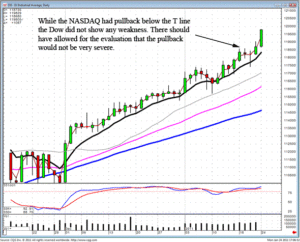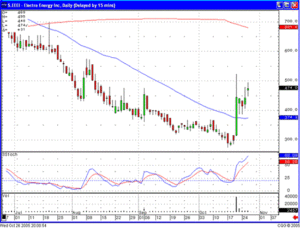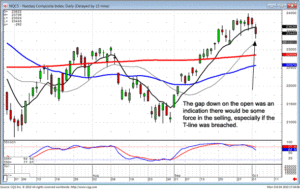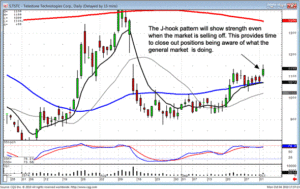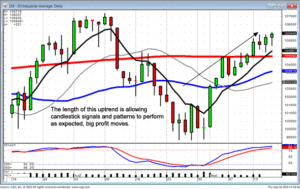Trading during a recession or other times of economic stagnation is often more successful than investing. When trading during a recession traders can profit whether the stock market or individual stocks go up or down. With strategies such as options trading it is possible to leverage investment capital while also limiting investment risk. Trading during a recession allows traders to profit from swings in stock price even when long term stock market trends are flat or declining. It is always wise when trading during a recession or at any time to do fundamental analysis of the stocks that one trades. Intrinsic stock value and margin of safety are drivers of eventual stock price and give traders a clear idea of stock price potential and likely trading range. However, when trading during a recession, as in most trading, Candlestick stock charts provide traders with a clear view of market sentiment. Using Candlestick analysis traders can sell stock, buy stock, sell short or profit in options by buying calls or buying puts. Technical analysis with Candlestick signals gives traders the ability to profit no matter what the economic conditions and not matter which direction the market is going.
During a recession those interested in long term investing often shop for bargains, a stock with strong fundamentals, a low price to earnings ratio, and the promise of renewed success when the economy picks up. The problem for investors is that this recession could last for a decade if analysts are right. The monumental debt burden in the two greatest economies of the world, the USA and the EU, combine to present a drag on economic growth that will eat away at long term profits and growth. However, the ups and downs the stock market caused by brief market trends and market reversal provide profit opportunity for stock traders. With the use of technical analysis tools such as Candlestick chart formations traders can anticipate changes in market sentiment. Using Candlestick trading tactics traders can profit from both the rise and fall of stock prices.
Using easy to read Candlestick signals, traders avoid being defeated by the psychology of trading. It is all too easy to become euphoric at what may appear to be a market breakout and all too easy to become distraught when the market falls. Candlestick patterns guide trading with statistically accurate appraisals of market patterns. Because markets repeat themselves a Candlestick signal gives a clear signal of coming price activity. Traders can avoid being tricked into poor choices by following the advice of the Candlesticks. In trading during a recession there often emerges an attitude among both traders and long term investors that things are just not going to get any better. That may be the case, even for a year or two. However, not all stocks languish during a recession. And, there is always market activity, up and down, as traders test the market. Those willing to do their homework and use the clear signals of Candlestick pattern formations can profit by trading at all times, including trading during a recession.
Candlestick signals have a more relevant value than just identifying reversals in a trend. Once an investor understands the psychology that created each signal, they have an immense understanding of why prices move as they do. This information can also be applied when analyzing price patterns. Whether utilizing Western patterns or Japanese candlestick patterns, analyzing each individual signal in conjunction with the surrounding signals allows an investor to project the next price movement with an extremely high degree of accuracy. This is applicable to 1 min. charts as it is to a monthly chart. Japanese candlesticks signals are fractal, meaning they work equally well during any time frame. Where most investors fail is putting too much weight on a trading program that is supposed to work well. When it does not, many investors are prepared to move on to the next promoted trading technique. Fortunately, the candlestick investor has one dynamic that dramatically reduces the risk of learning the correct trading method. Japanese candlesticks have been honed over the past 400 years. This makes learning candlestick analysis much easier. An investor does not have to worry about whether they are wasting time and energy and money learning a trading program that has not yet been proven. Japanese candlesticks are the most proven trading method in the world.
Chat session tonight at 8 PM ET, Everyone is welcome!
Good Investing,
The Candlestick Forum Team
Website special reflects current newsletter. If you are reading an archived newsletter you will be directed to Current Website Special
